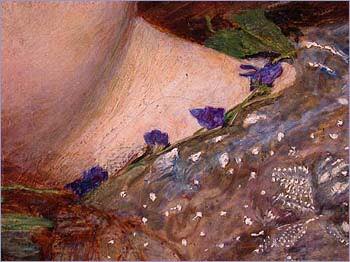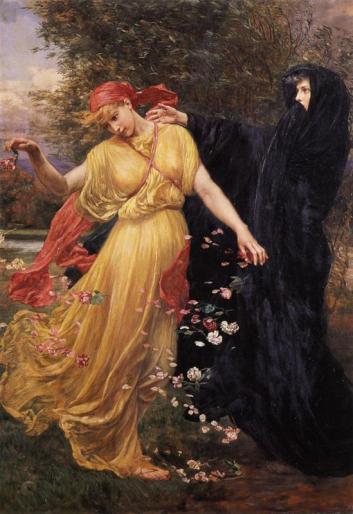“Bury the dead deeply, water its grave with streaming eyes, and in spring-tide pluck a withered violet or some other sweet-scented blossom from the green sod” – ‘The Writings of Althea Swarthmore’ (Collected in ‘A Night On The Moor, and other tales of Dread‘), by R Murray Gilchrist.
I was inspired to write this post by Gilchrist’s line, which made me think how a symbolic knowledge adds depth and nuance to even simple statements. Gilchrist can be almost as dense in his writing as the fogs that settle on the Peak District settings of his horror fiction but a little knowledge of the symbols and thoughts he employs will help us navigate both his work and the work of many other artists.
“[Ophelia] – I would give you some violets, but they withered all when my father died”
(Hamlet: IV.v.181-183)

Violets are a symbol of constancy and faithfulness, but equally of untimely death in the young and melancholy. This leads the flower to be identified not only as a reminder of the natural cycle of life, death and rebirth but as a catalyst to transition; from maiden to wife, innocence to knowledge, life to death…

Persephone was gathering violets when Pluto rose from the underworld, enamoured with the maiden, and drew her down into his shadowy domain. Her abduction caused great despair in her mother, Demeter, who neglected her duties as harvest goddess while searching vainly for her daughter (using, interestingly, the twin torches of Hecate to cast light into dark places). This neglect led to fruits withering on the branch, crops rotting in the field and starvation in the people of the Earth. Zeus, petitioned by the starving, commanded Pluto to release Persephone to her mother for two-thirds of the year, the summer-time of sowing and harvest. She would then return to assist her husband in judging the dead for the remaining third of the year, the winter-time of sorrow.
Many of the Persephone myths show her as an unwilling victim, abducted and forced into a relationship that takes on something of the Stockholm Syndrome. A handful, however, show Persephone as willingly taking on her role as arbiter of both Life and Death; she tempers her husband’s stern views but is also fully aware that the hope she gives the living is ultimately doomed.
“Violet! Sweet violet! Thine eyes are full of tears; Are they wet, even yet, with the thought of other years?” James Russell Lowell
(The title of this post is taken from ‘The Waves’, by Virginia Woolf, almost herself a modern Ophelia. Valentine Cameron Prinsep was Virginia Woolf’s maternal great-uncle).
